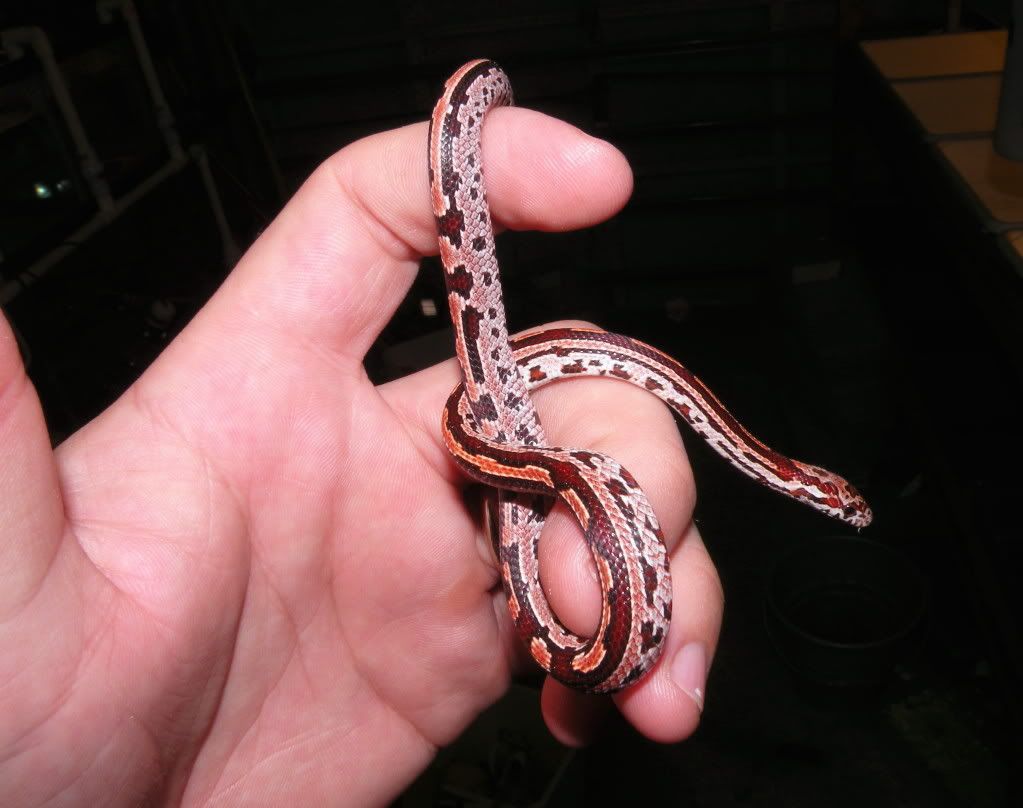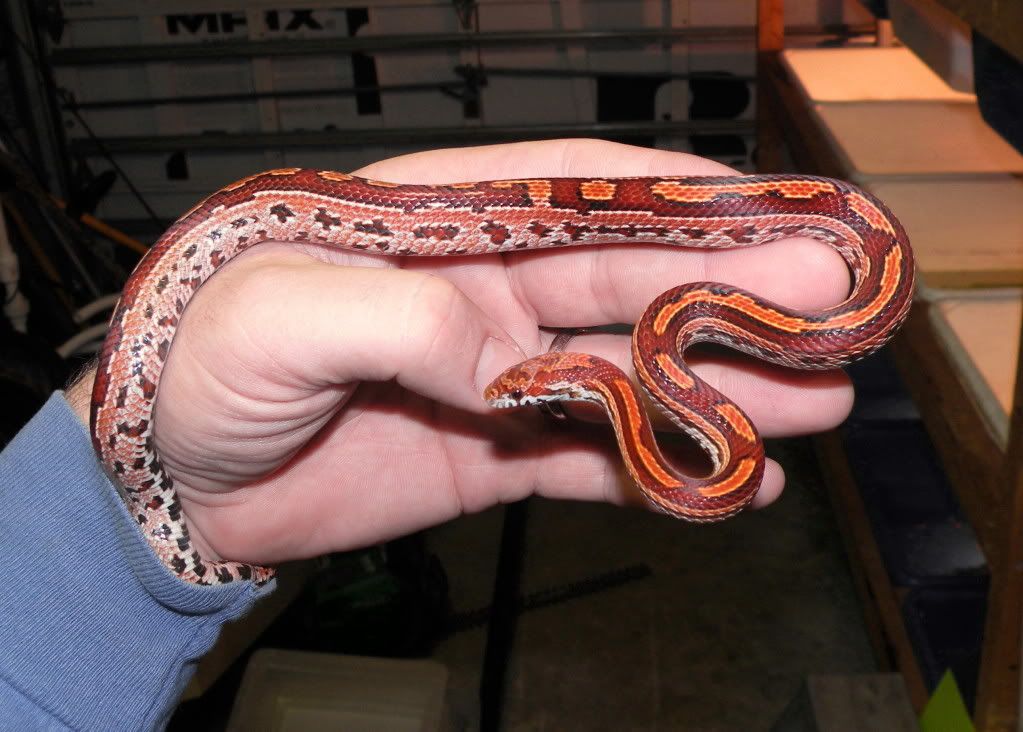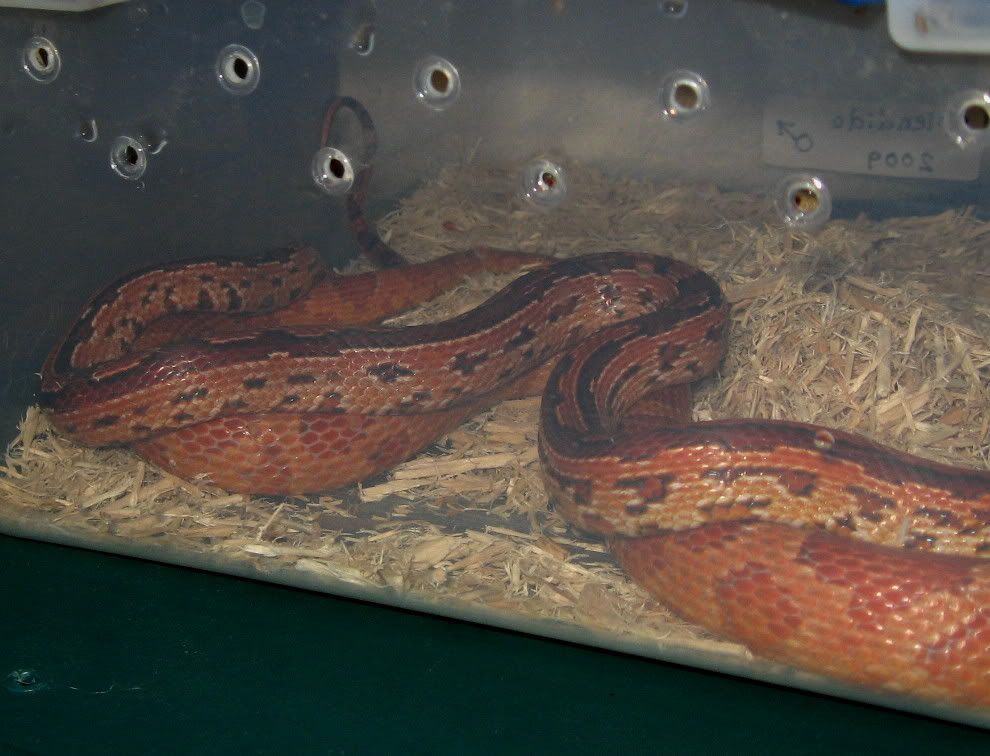Mitchell Mulks
New member
HOLY CRAP TOM! That SK Okeetee is unreal!!!!!!!
My prediction is that after four generations I'll be able to post one of the hatchlings and no one would be able to differentiate between it and a "pure" tessera. Mitch
breed your known hybrid to very normal unrelated corns and can consistrently produce 50% Tessera phenotypes AND 50% very NORMAL CORNS everytime!.....you know, just like ALL the Tesseras do out there.
So, it's well documented that the human and chimp genomes are greater than 98% identical because of shared common ancestry. That means, all the dna that comprises the 23 different chromosomes in humans is 98% or greater identical. Therefore, less than 2% of differing dna between humans and chimps is what makes our two species different from one another. Similarly, it's been shown that corns and kings arise from common ancestry, so I'd imagine the difference in their genome is only due to a few percent too.
When a striped cal king x corn cross is performed, yes, the offsprings genomes are comprised of 50% cal king and 50% corn. However, and this is a big deal, very few of the genes handed down from each parental species differs from one another. Most of the time, an F1 hybrid, when chromosomes align, the genes residing at a particular loci on sister chromosomes will be identical; therefore it makes no difference which species passed down that portion of the hatchling's genome. Occasionally though genes at the same loci will differ because they evolved in different directions when cal kings and corns diverged from their most common ancestor. It's those conditions, when the genes are heterozygous with respect to which species donated the genes, that makes hybrids look unlike either of the parental species.
So, if less than 2% of the genome between a corn and king (since they are highly related I'd imagine it's around this number) differs, then even a much smaller fraction of those differences are probably responsible for the phenotype of the animal that we see when we look at them. Some of the genomic differences between species will affect organ function, some maybe on how metabolism functions, but for certain not all the genomic differences between the two species will affect the pattern and physique of the snake.
When you create a jungle corn by breeding a cal king to a corn, the only traits we can artificially select are the ones we can see. The gene responsible for the tessera pattern is one of those genes. It's dominant in that with only one copy of the gene at a single loci, regardless of which copy of the gene (cal king or corn ) sits at the other loci on the sister chromosome, the pattern will forma a thing dorsal stripe and tessellated lateral flanks. After the first hybrid event, from the F1's, the person orchestrating the artificial selection experiments will choose to hold back only those offspring with the tessera pattern, and a body type and pattern that most closely resembles a corn snake. From this choice the breeder is propagating the dominant gene that makes the tessera pattern and any other genes that more closely resemble a corn snake. When that F1 is bred to a pure corn to make the F2 generation we say that ~75% of the genome of the hatchlings will be corn snake and ~25% cal king (however, it's possible for the F1 snake to donate all corn snake genes to the F2 offspring, making the F2's 100% corn...but odds dictate that is HIGHLY unlikely to occur. But what does occur is the F2 offspring are now ~75% corn snake. Of that 75% corn snake genome, only a fraction is actually responsible for creating the phenotype that the breeder selects. Every time the breeder does subsequent pairings he or she is ALWAYS perpetuating the tessera gene, and a greater and greater majority of genes that create the morphological characters we associate with corn snakes. The cal king genes are eliminated from these subsequent lines, therefore greatly reducing any king snake 'noise' you'll see in pattern development. By four or five generations the majority of the genes responsible for actually creating the corn snake phenotype have been selected and perpetuated by the breeder, all the while the king snake genes have been eliminated from the strains. Because the behavior of the tessera gene is dominant when in a heterozygous state, when one of the hatchlings doesn't receive the tessera gene, the majority of the pattern genes are now corn snake...so the F4 and F5's will look almost identical to pure corns.
It's very straight forward how this occurs genetically, and it's very possible to artificially select against the majority of cal king pattern genes that have the largest affect on pattern development. Within a few generations the vast majority of genes actively dictating pattern and physique development will be corn snake in origin, with only the tessera pattern gene always being selected for because it's easy to identify. It's actually quite possible that over four generations you could still have a nearly 50-50 ratio of corn to cal king genes, with the main difference between that being that the breeder has artificially removed the minute number of genes responsible for creating the cal king pattern from the equation! Therefore, you could have created a snake that is identical to the tessera corns we love, but is a 50-50 hybrid genetically!!!! That's the really cool thing about genetics. It also demonstrates the sheer power associated with artificial selection. Humans have been artificially selecting pattern elements of foods and animals for thousands of years. Do you think they were thinking about genes when they held back seeds from corn that produced larger kernels and bigger reproductive fruits? No, they were simply thinking "larger is better". They were unconsciously doing away with the genes for small growth, and favoring the genes for larger fruit! The same thing, in my opinion, has been done with tesseras.



Mitch, producing one that cannot be distinguished from a Tessera isn't the key here at all. The only thing that would give any credence or matter at all is if you breed your known hybrid to very normal unrelated corns and can consistrently produce 50% Tessera phenotypes AND 50% very NORMAL CORNS everytime!.....you know, just like ALL the Tesseras do out there.
Please stop portraying like I am some emotional newbie when it comes to genetics. I don't own a single Tessera anyway, but I do have some good common sense and logic. When you can produce the very simple clutches just as I described above, then I will be the first to admit I was very incorrect about all this.
~Doug
Progression shots of a hatchling found in the isolated wilderness near Everglades National Park in extreme southern Florida. This thing is very tesselated on the flanks as well as having striped, motley and aztec areas throughout. This certainly gives proof that a pure wild corn can display those odd characteristics too.
Okay Doug & all
I keep a very few hybrids. Six to be exact. A Cornduran, A Sinacorn, a Pueblacorn, two (2012) Cremesicles, and got this gal earlier this year on a trade. I was planning on pairing her with the Cornduran in 2013.
However, as many here seem interested, for butter or for worse, in seeing the results, I will go ahead and pair her with a pure corn. While the pure corn I have is not wild caught, he is also not het for motley, not het for stripe, not het for any lengthwise pattern. Because I feel breeding a stripe or tessera or pattern morph to her would prove nothing. So therefore I will pair her with the Landrace Lava 50% poss het sunkissed, because it has been indicated that these are so pure. This assuming the male has any interest in her. I'll dig up this thread and post results, and do the ethical thing to do with any baby snakes which do not look like obvious hybrids.
After which time she will need a new home.
Is this an acceptable means of settling anything?
In the event the Landrace Lava does not have a matinee with her then I'll pair her other corn males within the same parameters.
And even then will it prove that tessera is truly anything other then a gene shared through common ancestry, in the same way which amel, anery & so forth are?
It's an offer on the table. Let me know.
Thanks for sharing,
dave
Very cool!
Doug, have you demonstrated whether the pattern on that wild-caught is heritable? I remember when you originally posted that thing. Good to see it again.
Perhaps you are considering the tesseras with the broken up pattern/incomplete stripe down the back as 100% tessera? They look intermediate to me. I think Joe's price is right considering the quality.
Personally I would have sent them to Korea with the rest of the scrap from asst'd projects. Keep the price stronger in this country. I know, too much work. Let's crash the market on ourselves and then point the finger elsewhere.
Remember back when the first tess were available?
no hets listed. hefty price.
BHB tess, no hets listed, hundred bucks.
All these other breeders listing tess with hets, a little more money. not much more money. Are we crashing the market on ourselves by getting ten bucks more for each p/het listed?
I hope I never view babies I brought into being as "scrap." If I ever do, it's time to GTF out of snake breeding.
Dave, is that a single anal plate I am seeing on that snake?
Is there ANYBODY out there that has a KNOWN Tessera that has a SINGLE anal plate?
